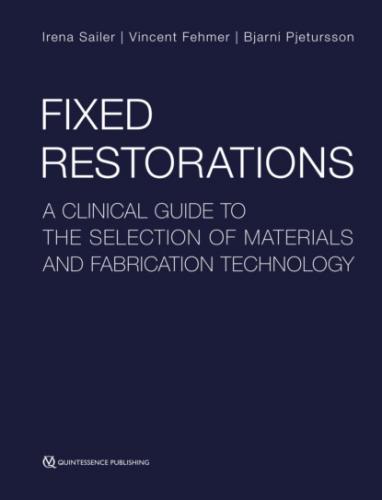Fixed Restorations. Irena Sailer
11 after the removal of the composite restoration and prior to minimally invasive preparation.
Fig 1-3-3b Minimal buccal reduction.
Fig 1-3-3c Feldspathic restoration (veneer) 11 after adhesive cementation.
Fig 1-3-3d Minimally invasive preparation of 43–31 and 33 affected by odontogenesis imperfecta.
Fig 1-3-3e Circumferential preparation with a reduction of tooth substance less than 0.8 mm
Fig 1-3-3f 360° Veneers based on glass-ceramic in regions 43–31 & 33.
Fig 1-3-3g Universal, classic crown preparation tooth 11.
Fig 1-3-3h Circumferential preparation with a reduction of tooth substance of ca.1 mm.
Fig 1-3-3i Veneered zirconia crown 11. (DT: Walter Gebhard, Zürich)
Fig 1-3-3j Classic crown preparation after removal of an old insufficient crown 21.
Fig 1-3-3k Circumferential preparation with a reduction of tooth substance of 1.2 mm on discolored abutment tooth.
Fig 1-3-3l Microveneered zirconia crown 21.
Fig 1-3-3m Rather invasive crown preparation of non-vital abutment tooth 11.
Fig 1-3-3n Circumferential preparation with buccal reduction of tooth substance of 1.5 mm.
Fig 1-3-3o Porcelain-fused-to-metal crown 11. (DT: Belinda Sapina, ZZM Zürich)
Degree of discoloration of the abutment tooth
The fourth and final step in the evaluation for material selection is also based on technical aspects and involves the assessment of the abutment tooth color and its effect on the restorative material. The abutment tooth may be subdivided into three categories: (1) normal color with a homogenous appearance; (2) slightly to moderately discolored; and (3) severely discolored with metal build-ups.
The choice of material is specifically critical in the latter group. On one hand, the dark color has to be masked. On the other hand, the dark color of the abutment tooth and its roots may negatively affect the appearance of the surrounding gingiva. Since all-ceramic materials including zirconia allow the transmission of light at the material-specific wall thickness, it is recommended to use glass-ceramic as framework material only for an uncolored or slightly discolored abutment tooth (Fig 1-3-4)10.
Fig 1-3-4a Normal-colored homogenous abutment tooth: no need to mask. Glass-ceramic allows the ideal transmission of light.
Fig 1-3-4b Slightly discolored abutment tooth. Minimal need to mask. Similarly, glass-ceramic allows the ideal transmission of light.
Fig 1-3-4c Moderately to severely discolored abutment tooth with slight grayish discoloration of gingival margin: minimal need to mask. To be restored with slightly increased value of opacity in the glass-ceramic or a translucent zirconia core.
When restoring moderately to severely discolored abutment teeth, the material selection also depends on the available space. If, for example, zirconia was selected as the material of choice based on the brightness value and the translucency of the reference teeth (Fig 1-3-5a), a higher minimum thickness for the core material has to be respected for moderately to severely discolored abutment teeth. In clinical situations with severely discolored abutment teeth an esthetic outcome may only be achieved by the use of high-noble alloy as framework material. Metal-ceramic restorations with a core thickness of 0.3 mm may offer sufficient firing stability and completely mask the underlying staining (Figs 1-3-5b and c).
Fig 1-3-5a Severely discolored abutment tooth with gold build-up and apparent discoloration of marginal gingiva: need to mask. To be restored with a zirconia core with minimal thickness of 0.4 mm.
Fig 1-3-5b Severely discolored abutment tooth with gold build-up and obvious discoloration of marginal gingiva: need to mask. To be restored with a zirconia core with minimal thickness of 0.6 mm or a classic porcelain-fused-to-metal crown.
Fig 1-3-5c Extremely discolored abutment tooth with dark gold build-up and strong discoloration of marginal gingiva: maximal need to mask. To be restored with a classic porcelain-fused-to-metal crown to achieve predictable esthetic outcome.
1.3.4 Monolithic and veneered restorations
Lithium-disilicate and zirconia ceramics are available in different shades and levels of translucency today, allowing for a monolithic application of both ceramics in most clinical situations (for more details, see Part I, Chapter 1). Lithium-disilicate is solely indicated for the restoration of single teeth (overlay, crowns) or single implants, while zirconia can be used for the fabrication of tooth- and implant-supported single- and multiple-unit fixed dental prostheses. These indications result out of the differences in mechanical stability of the different ceramics (see Part I, Chapter 1).
Until recently, zirconia was only available as yttria-stabilized tetragonal zirconia polycrystals – a non-esthetic, rather opaque whitish framework material which had to be veneered. As presented in Parts III and IV of this book, very high rates of chipping of the veneering ceramic were reported in the scientific literature leading to rising doubts with respect to this restorative material. Due to modifications of the crystalline structure of zirconia (tetragonal –> cubic zirconia) increased translucency of the ceramic was achieved. Furthermore, color modifications improved its esthetic appearance. Therefore, a monolithic or microveneered application of zirconia is possible today. However, as the mechanical stability of the translucent and shaded zirconia types differ significantly between the grades of translucency/shade and, even more, between the manufacturers. This leads to indications
